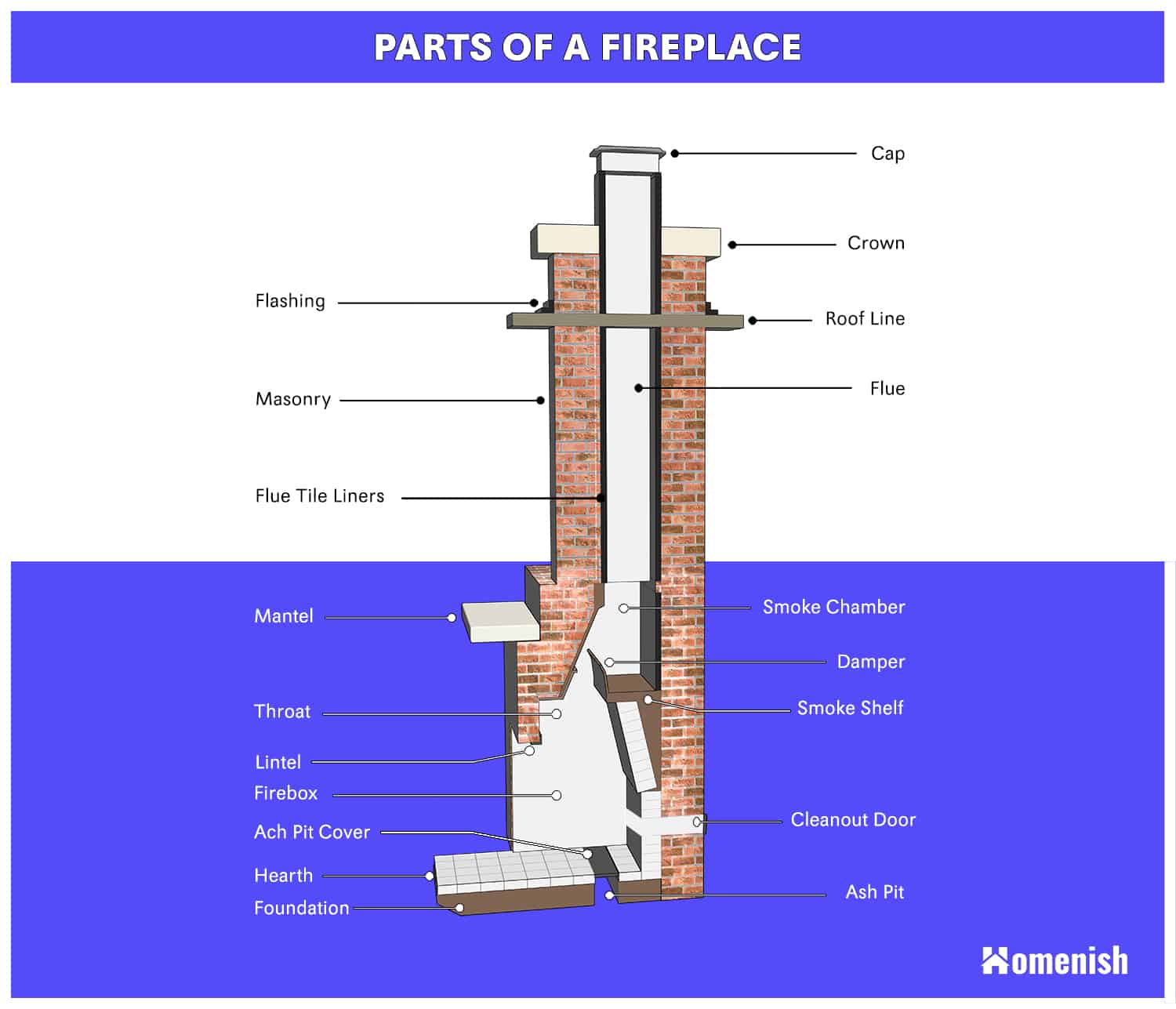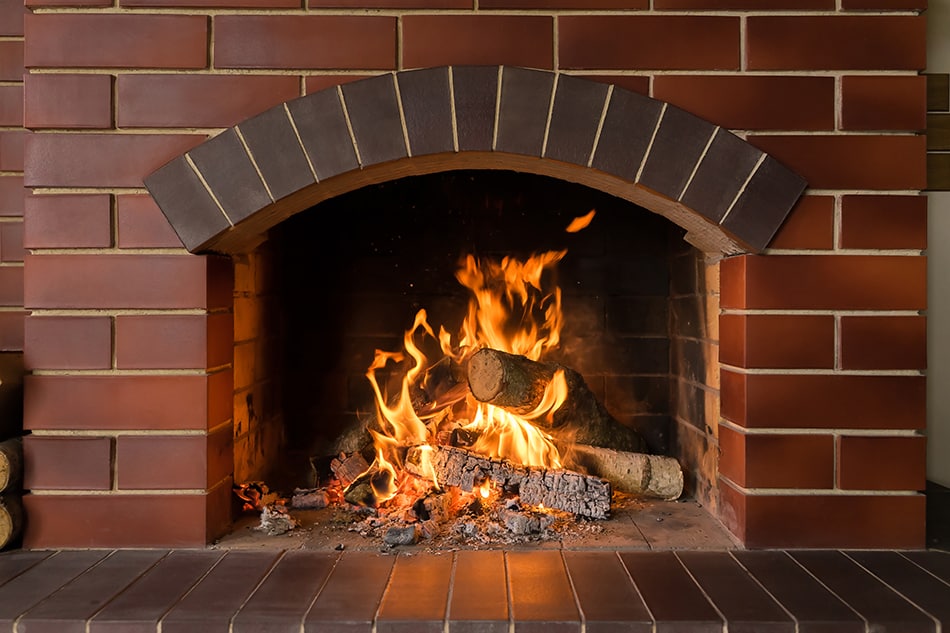Nothing is more relaxing than having a fireplace crackle away while you sip on hot cocoa during a cold day, but what exactly makes them tick? Although many have a fireplace already installed in their homes, a majority do not know how they work. Understanding how these household staples function and what their actual individual parts are will help you maintain them and prevent accidents from happening, and it is certainly more than just meets the eye.
The fireplace is distinct from the chimney and has its structure, but both require skilled chimney cleaning at least once a year. Are you familiar with your fireplace’s different components? It’s possible that you’re not even aware of how your fireplace works and that by reading this, you’ll be able to make more use of it.
Here is a 3D design of the fireplace anatomy.

Table of Contents
The Foundation
Laid at the bottom of the fireplace, the foundation plays an important part in providing a firm base for the fireplace. It also has to built with durable materials like cinderblocks, and specialized bricks to withstand heat from hot ash.
Chimney Cap
The last thing you want is any of these things coming in through your chimney and into your fireplace and damaging it: water, critters, and debris. Rainwater from extremely strong weather, small animals like squirrels, and leaves all have their ways of sneakily getting inside your chimney and wreaking all kinds of havoc on your fireplace. To stop that from happening, chimneys are usually equipped with a chimney cap; however, some do not have one; but one can easily be installed by a professional.
Mantel
The top of the fireplace, which is visible in plain sight when looking from inside the room, we start with the mantel. Whether it is for hanging the stockings on Christmas or just the permanent home of many a family photo, the mantel is not only a cosmetic addition to the fireplace but rather an integral, structural, and functioning part of it. The mantel most often serves as a shelf upon which decorations and other items can be placed, but it also prevents smoke from the fire wafting into the room, which can be unpleasant, to say the least. The materials that mantels are going to be made of, most often than not, will depend on which of the following two items your fireplace is equipped with.
Fireplace Face
Made of non-flammable materials like the ones which make up the hearth, i.e., concrete, stone, granite, etc., the fireplace face is the opening that sticks out from the actual fireplace and into the room. For aesthetic reasons, the fireplace face can be painted to match the firebox or hearth. This part can also be replaced by the next item on this list.
Surround
Unlike the fireplace face, which is strictly non-flammable, the surround is “strictly” decorative. For the most part, surrounds have been made of wood. To complement the style, design, or color of the hearth, fireplaces with surrounds have a back panel. The back panel is, on the whole, located between the surround and the opening of the fireplace.
Firebox
As the name suggests, this is where the fire rages. To cope with the enormous amount of heat being put into them, this part of the fireplace is usually surrounded by materials like firebricks and other non-flammable building materials. Most fireboxes are constructed either as a rectangle or a square. Oftentimes, fireboxes are painted to match the other parts of the fireplace, but they come in all shapes, sizes, and colors.
Hearth
This is usually the base of the fireplace that you can see. The hearth can be split into two parts. The one that reaches out into the room is the outer hearth; this prevents hot embers from burning your floor or any unfortunate soul who gets too close. The one that extends inward and forms the base of the firebox is the inner hearth.
The hearth is the heart and soul of the fireplace, and it is around this that the rest of the fireplace is more often built. Aside from the fireplace being built around it, the fire itself is typically built here; sometimes, the fireplace grate is placed on top of the hearth.
As it was with the firebox, the hearth has to deal with extremely high temperatures. So, this essential part of the fireplace, which insulates the floor of your home from the intense heat of the fire, requires insulating non-combustible materials too like granite, marble, stone, concrete, brick, ceramic, and quarry tiles.
Lintel
Opposite the hearth and on top of the firebox lies the lintel. The primary purpose of this part is, by and large, structural. Located between the throat of the chimney and the fireplace face or surround, the lintel helps spread the weight of the chimney breast across the sides of the fireplace, essentially stopping the front of the fireplace from caving in on itself and saving you a whole lot of hassle.
Chimney
Now moving up and inside is what ensures that your fireplace runs efficiently and safely—the chimney. Without this key part of the fireplace, noxious gases along with smoke and other nasty things would have nowhere to go but out into the room in which the fireplace is installed. The chimney provides a safe passage for all the waste smoke from the fire and out of your home. This part traditionally starts at the top of the firebox and extends upwards through the roof of the house and beyond. Allowing the chimney to stick up enough away from the roof ensures enough of a draw to make the fireplace safe.
Chimney Throat
The bottom of the chimney, where it meets the firebox, is called the chimney throat. Aside from containing fire-resistant materials, it also, in some cases, contains a damper, although dampers may also be located at the top of the chimney.
Damper
As said before, the damper can either be at the bottom or the top of the chimney, and depending on the case, it can be operated using a lever or a chain that hangs down. Dampers prevent heat inside the house from escaping up through the chimney and out into where it is less needed. The draft blowing on the fireplace can also be reduced by closing the damper. However, before a fire is started, it is good to open the dampers to stop the smoke from coming into the house rather than up and out the chimney.
Smoke Chamber
Right on top of any throat damper or at the top of the chimney throat, the smoke chamber is where the chimney narrows, and its purpose is to compress and compact any gas let out by the fire.
The Throat
The opening above the fireplace where the smoke and fireplace escapes is the throat. It is important to build a throat large enough for the heat to exit but not too large for it to escape so fast. Also, the throat has to be built with an appropriate height at least 8 inches high from the inner heart.
Ash Pit
Ash pit, which is laid below the ash dump, is the remnant of the materials that are burned in the fireplaced
Cleanout Door
You can remove, and clean the ash dump through the cleanout door, which is on the bottom half of a fireplace.
